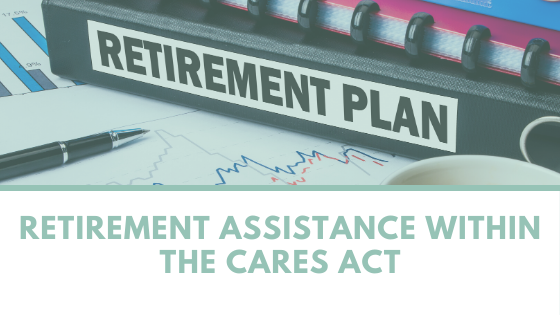
Retirement Assistance Within the CARES Act
In late March 2020, as the number of novel coronavirus cases in the U.S. surged past 100,000, the Coronavirus Aid, Relief, and Economic Security (CARES) Act was passed into law.1 The CARES Act provides around $2.2 trillion in aid to businesses and individuals who have been impacted by shelter-in-place orders, government-mandated business closures, and large-scale job losses.
However, some of the CARES Act’s provisions aimed at retirement accounts can also benefit those who are as yet untouched by the coronavirus crisis. Learn more about the specific retirement assistance contained within the CARES Act.
Tax-Favored Withdrawals
In 2020, individuals under age 59.5 can withdraw up to $100,000 from their employer-sponsored retirement plans without paying the traditional 10 percent penalty tax if they fulfill a couple of conditions.2 To qualify for the tax waiver, the individual and/or their spouse must have:
- Been diagnosed with COVID-19 through a CDC-approved test; or
- Experienced adverse financial consequences after being furloughed, laid off, quarantined, or having their hours cut; or
- Experienced adverse financial consequences due to school closures and lack of childcare.
If the distribution is repaid within three years, the distribution is considered a tax-free rollover, which means that the individual will never need to pay taxes or the 10 percent penalty on what they (temporarily) withdrew. For qualified individuals, this can provide a financial lifeline during an unprecedented economic period.
If the qualified individual is unable to repay the withdrawal within three years, the distribution will be included in their income over a three-year period beginning with the year in which the distribution is made (2020). Though this will still require the individual to pay taxes on what they withdrew, by eliminating the 10 percent penalty and the 20 percent automatic tax withholding, this provision can put more money into a person’s pocket when it’s needed the most.
Plan Loans
Prior to the CARES Act, retirement plan loans were capped at the lesser of $50,000 or 50 percent of the participant’s account balance. And with the recent stock market drop, this left many 401(k) holders with fewer options than they had just a few months before.
The CARES Act doubled these limits for 180 days after its enactment; qualifying individuals can now withdraw the lesser of $100,000 or 100 percent of their account balance through a retirement plan loan. Furthermore, those who take out a plan loan on or after the effective date of the CARES Act have until December 31, 2021 to repay the loan.
RMD Waiver
Those who are over age 72 and therefore required to take required minimum distributions (RMDs) from their retirement plans are in luck—instead of withdrawing these RMDs in 2020 (and risking losses from the recent stock market drop), these individuals can either roll over the RMD or decline to take it entirely. This one-year waiver applies only to RMDs required to be taken in 2020.
Important Disclosures:
The opinions voiced in this material are for general information only and are not intended to provide specific advice or recommendations for any individual. To determine which investment(s) may be appropriate for you, consult your financial advisor prior to investing. All performance referenced is historical and is no guarantee of future results. All indices are unmanaged and cannot be invested into directly.
The information provided is not intended to be a substitute for specific individualized tax planning or legal advice. We suggest that you consult with a qualified tax or legal advisor.
LPL Financial Representatives offer access to Trust Services through The Private Trust Company N.A., an affiliate of LPL Financial.
LPL Tracking # 1-977645 (exp. 12/21)
1 https://www.nytimes.com/interactive/2020/us/coronavirus-us-cases.html